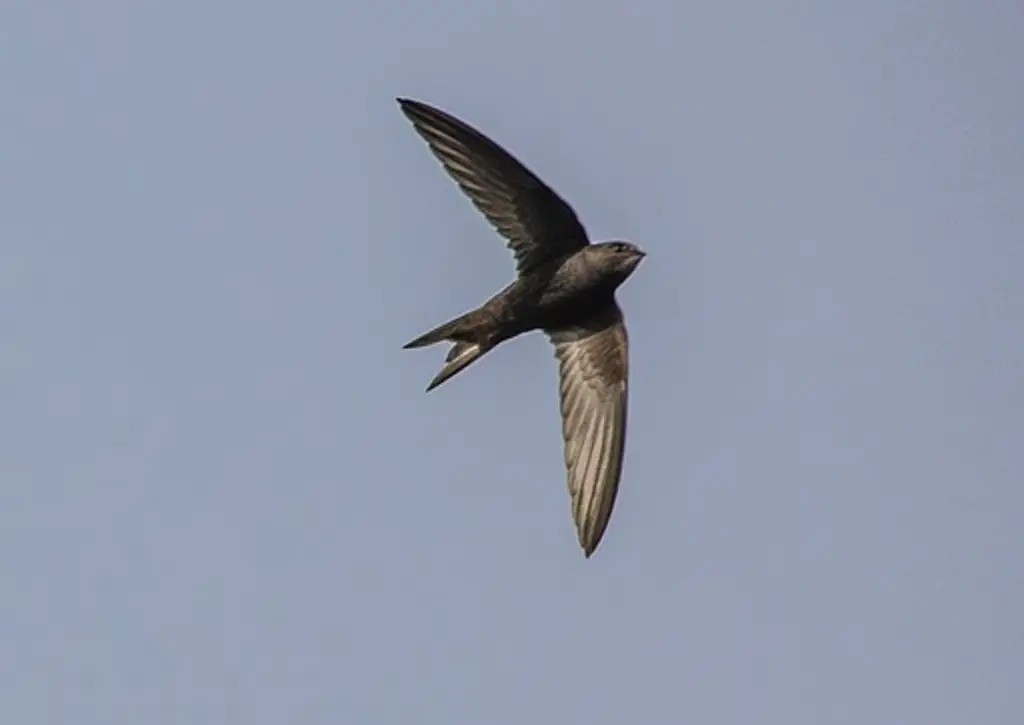Have you ever seen a bird soar through the sky and thought, “Is that a bat?” It’s more common than you think! Some birds share astonishing physical similarities with bats, like their wing shapes and flight patterns. These creatures may leave you questioning what’s flying above you!
In this article, we’ll reveal 7 birds that look like bats, and you’ll be amazed by how these animals are more alike than you ever imagined. Keep reading—you won’t believe the surprising connections between them!
Click the Play button below to listen to our podcast:
Table of Contents
Bats: The Nocturnal Mammals
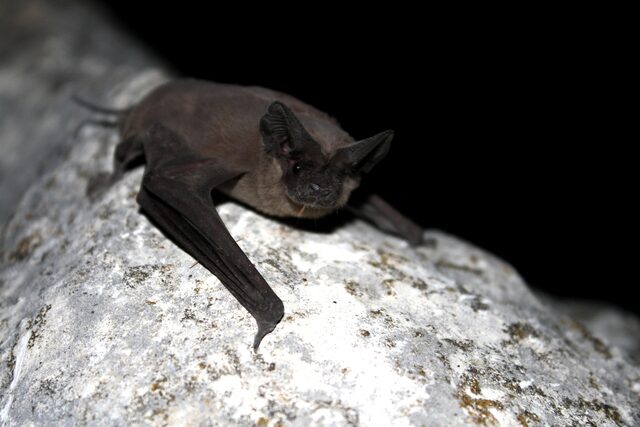
Bat Anatomy and Behavior
Bats have a distinct anatomy that allows them to fly with incredible agility. Their wings are made of thin, flexible membranes stretched over elongated finger bones. Bats are also known for their sharp teeth and echolocation abilities, which they use to navigate and locate food in the dark.
Importance of Bats in Ecosystems
Despite their reputation as spooky creatures, bats are incredibly beneficial to ecosystems. They are primary pollinators for many plant species, including important crops like bananas and agave. They also play a crucial role in controlling insect populations, with some species consuming thousands of insects each night.
Threats to Bat Populations
Unfortunately, many bat populations are under threat due to habitat loss, disease, and other factors. It’s important to understand the crucial role that bats play in ecosystems and to take steps to protect them.
Protecting Bat Populations
Protecting bat populations involves conserving natural habitats, controlling the spread of disease, and educating the public about the importance of bats. By working to protect bats, we can help to maintain the delicate balance of ecosystems and ensure a healthy planet for future generations.
Types of Birds That Look Like Bats
Common Swift

The Common Swift, is a fascinating bird that is widely distributed throughout Europe, Asia, and Africa. These birds are migratory and spend most of their lives in the air, only landing to nest and raise their young. Their preferred habitats include cities, cliffs, and forests.
They feed on a variety of flying insects, which they catch while in flight using their wide mouths and sharp beaks. The Common Swift is a remarkable bird, with a lifespan of up to 20 years and the ability to fly up to 10 months without stopping. The Common Swift shares some similarities with bats, including their nocturnal habits and flying behavior.
However, there are many differences between these two creatures. While bats have wings made of thin, flexible membranes, the Common Swift has long, pointed wings that enable it to fly at incredible speeds, and are often seen flying in a similar pattern to bats, with quick, darting movements..
Bats are typically nocturnal, while Common Swifts are diurnal, meaning they are active during the day. In terms of color, Common Swifts are dark brown or black, while bats can vary in color from brown to gray to black.
Common Nighthawk
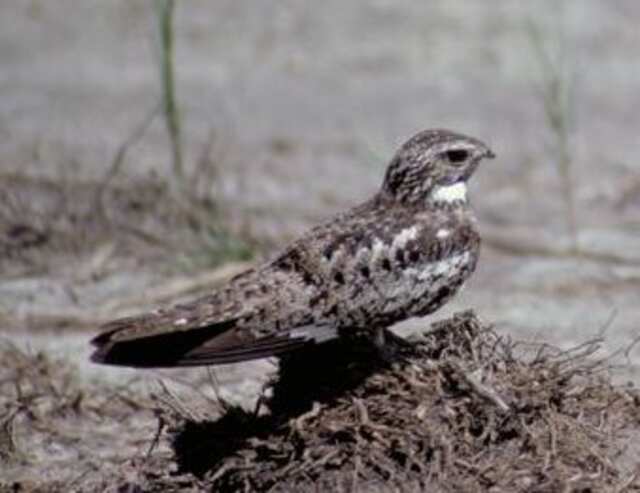
The Common Nighthawk is a fascinating bird that can be found throughout North and South America. This species prefers open habitats such as grasslands, forests, and urban areas, where it can easily hunt for insects, which make up the bulk of its diet. The Common Nighthawk is also known for its unique vocalizations, which can be heard during the breeding season.
When it comes to similarities and differences with bats, the Common Nighthawk does share some characteristics. Like bats, they are nocturnal and are active during the night. They also have a similar body type, with long, slender wings and a streamlined body that allows them to fly with great agility.
However, unlike bats, the Common Nighthawk is not capable of true flight, instead relying on gliding to move through the air. Additionally, they have a distinctive coloration, with mottled brown and black feathers that provide excellent camouflage during the day.
Barn Swallow
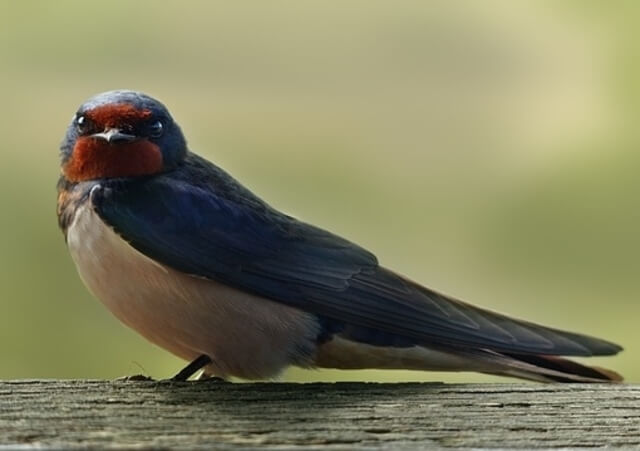
The Barn Swallow is a beloved bird species found in a variety of habitats around the world. With a range that spans from North America to Europe, Asia, and Africa, the Barn Swallow is a highly adaptable bird that can thrive in a range of environments. This species typically nests in barns or other structures, and feeds on a diet of insects and other small invertebrates that it captures on the wing.
Despite their differences, there are some interesting similarities between Barn Swallows and bats. Both are highly agile flyers, with the ability to dart and swoop through the air with incredible precision. However, while bats are nocturnal and use echolocation to navigate in the dark, Barn Swallows are diurnal and rely on their sharp eyesight to find food during the day.
Additionally, while bats have a distinct body type and wings made of thin membranes, Barn Swallows have a more streamlined body shape and wings that are more rigid and pointed. Finally, while bats are typically dark in color, Barn Swallows are known for their vibrant blue and rust-colored plumage.
Cedar Waxwing

The Cedar Waxwing is a striking bird species that can be found throughout North America, including Canada, the United States, and parts of Mexico. These birds are often found in habitats with fruit trees, as they primarily feed on fruits and berries. In addition to their distinctive crested head and black mask, Cedar Waxwings are known for their unique feeding behavior, where they pass berries back and forth between members of a flock.
While Cedar Waxwings share some similarities with bats, there are also many differences between these two groups of animals. Unlike bats, Cedar Waxwings are diurnal and are active during the day. They also have a sleek, streamlined body type and are not adapted for flight in the same way as bats.
In terms of color, Cedar Waxwings have a brownish-gray body with a yellow belly and red tips on their wings, which is quite different from the dark and ominous appearance of bats. Despite these differences, both Cedar Waxwings and bats play important roles in their respective ecosystems and are fascinating creatures to observe in the wild.
Belted Kingfisher
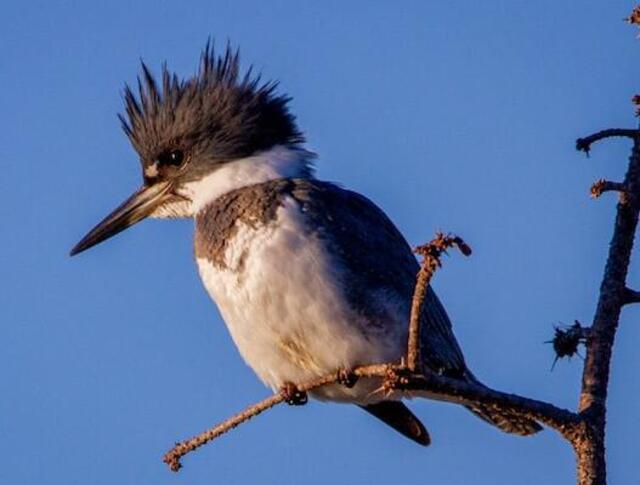
The Belted Kingfisher is a striking bird that can be found across much of North America. These birds are often seen perched on a branch or hovering over water before diving in to catch fish with their sharp beaks. Their habitat ranges from wooded areas to marshlands, and they can often be spotted near bodies of water such as rivers, lakes, and streams.
The Belted Kingfisher’s diet primarily consists of fish, but they will also feed on insects, crustaceans, and small amphibians. In terms of similarities to bats, there are few. While both are vertebrates, the Belted Kingfisher is a bird with feathers, a beak, and wings for flying. Bats, on the other hand, are mammals with fur, sharp teeth, and wings made of skin.
The Belted Kingfisher is diurnal, meaning it is active during the day, while bats are nocturnal and primarily active at night. Additionally, the Belted Kingfisher is brightly colored with a distinctive blue and white pattern, while bats are typically dark in color to aid in camouflage during nighttime flight.
Black Phoebe

The Black Phoebe is a small, sleek bird that can be found throughout much of western North America. These flycatchers are often seen near water sources such as streams or ponds, where they perch on branches or rocks to hunt for insects. Their diet primarily consists of small flying insects such as flies and mosquitoes, which they catch on the wing. The Black Phoebe is primarily dark gray with a contrasting white belly, making it a striking and easily identifiable bird.
Despite its name, the Black Phoebe is not completely black and can show some variation in color depending on age and sex. However, its distinctive black and white coloration helps to distinguish it from other similar flycatcher species. While the Black Phoebe’s flight behavior may resemble that of a bat, there are several key differences between these two species.
Unlike bats, the Black Phoebe is a bird with feathers, wings, and a distinct tail shape. It is active during the day, unlike most bat species, which are nocturnal. Additionally, the Black Phoebe is typically black or dark gray with a white belly, while bats are typically brown or black with a fur-covered body.
Chimney Swift

Chimney Swifts are fascinating birds that are found across North America. Their range extends from the southern regions of Canada all the way down to the Northern regions of South America. These birds prefer to inhabit dense forests, but have adapted well to urban areas, where they can be found nesting in chimneys and other structures.
Chimney Swifts primarily feed on flying insects, which they catch in mid-air using their wide mouths. Chimney Swifts share many similarities with bats, particularly in their flying behavior and nocturnal habits. Both species are adept at flying at high speeds and maneuvering in tight spaces.
However, Chimney Swifts differ from bats in their body type, with a slender and streamlined body covered in dark brown feathers. They are diurnal birds, meaning they are active during the day, while bats are nocturnal. Despite these differences, Chimney Swifts and bats both play important roles in their respective ecosystems and are fascinating creatures to observe in the wild.
Conclusion
In conclusion, while there are some physical similarities between birds and bats, there are also many differences that distinguish the two groups of animals. Birds have feathers and wings, while bats have fur and modified arms that allow for flight. Birds are diurnal and rely primarily on vision, while bats are nocturnal and use echolocation to navigate and locate prey.
It’s important to distinguish between birds and bats because they play different roles in ecosystems and require different conservation efforts. Birds are important pollinators and insect controllers, while bats also control insect populations but also help with seed dispersal and pollination.
By understanding the unique characteristics and roles of each group, we can better protect and conserve these important species and the ecosystems they inhabit.
Frequently Aked Questions
Birds that fly like bats?
Birds don’t precisely fly like bats, but some bird species, like swifts and swallows, exhibit agile, darting flight patterns reminiscent of bats. They excel at aerial acrobatics, soaring and swooping with remarkable agility.
Birds that fly at night like bats?
Nightjars and nighthawks are birds known for their nocturnal flight, resembling bats. They have specialized adaptations for low-light conditions and are often seen hunting for insects during twilight and nighttime hours.
Small birds that fly like bats at dusk?
Swifts are small birds known for their bat-like flight at dusk. They are highly maneuverable and can be frequently observed darting through the evening sky in search of flying insects.
Small birds that look like bats?
While no small bird exactly resembles bats, some birds, such as swifts and swallows, might be confused with bats due to their agile flight and silhouette. They are distinct avian species but share similarities in flight behavior.
Small bird that flies like a bat?
Swifts are a prime example of small birds that exhibit bat-like flight patterns. Their rapid and agile flight makes them adept at capturing insects in mid-air, similar to the hunting style of bats.

